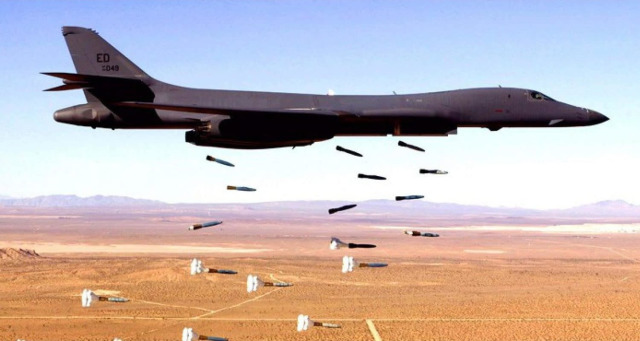As previously indicated in the first part of the article, currently only the US Air Force is armed with strategic bombers as one of the elements of the national nuclear triad. Despite the current level of development of air defense, this type of aviation technology continues to remain relevant in the field of nuclear deterrence.
The current fleet of strategic bombers of the US Air Force includes three types of aircraft: B-52 "Stratofortress" (Stratofortress), B-1 "Lancer" (Lancer) and B-2 "Spirit" (Spirit).
Strategic bomber B-52H "Stratofortress"
The first B-52 bombers reached initial operational readiness in 1952. The surviving aircraft operated today belong to the B-52H variant, of which 102 units were purchased in 1961-1962. Currently, there are 58 aircraft in the active forces, of which four are reserved as test aircraft. Another 18 units are in the Air Force reserve. According to American experts, the fact that the B-52s still form the basis of the US strategic bomber fleet - and the grandchildren of the first pilots actually fly – testifies to the reliability of the model.
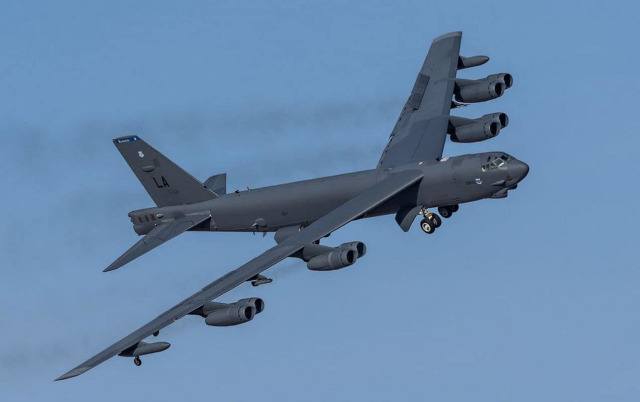
B-52H strategic BomberAccording to open sources, the B-52H modification has an operational ceiling of 15,000 m, develops a speed of Mach 0.84 (just over 1,000 km/ h) and has an operational range of 13,800 km (7,500 nautical miles).
The carrying capacity of the aircraft is 31,500 kg, transported inside the bomb bay and on underwing pylons. The aircraft carries both cruise missiles and gravity bombs and is designed for both conventional and nuclear munitions.
Since the aircraft cannot overcome modern air defense systems, it hits strategic targets only by using remote weapons. The B-52 can carry up to 20 AGM-86B cruise missiles with a nuclear warhead and a range of about 2,780 km (1,500 m. miles), or up to 12 unobtrusive AGM-129A cruise missiles with a nuclear warhead and a range of more than 3,700 km (2,000 m. miles).
It is also possible to use a long-range cruise missile (LRSO), which is planned to replace the AGM-86B by 2030. It is expected that the combination of speed, maneuverability and low visibility of the LRSO will provide deep penetration into the enemy's air and missile defense system even when launching from non-concealed aircraft. According to calculations, the combined range of strategic bombers and LRSO will allow hitting targets anywhere in the world.
It is reported that the current and planned modernization will extend the service life of the B-52H variant until the 2050s. Currently, the bombers are equipped with new Rolls Royce F130 engines. Collin Aerospace in January 2022 announced a contract for the modernization of the power generation system on the B-52. Together, these improvements will reduce fuel consumption by 30%, increase flight range and barrage time, and also allow you to gain cruising altitude faster. The increased power generation associated with the new equipment will contribute to further modernization, including a new radar with an active phased array antenna, as well as upgraded avionics, pneumatics and protective systems.
Strategic bomber B-1B "Lancer"
The B-1 Lancer achieved its operational readiness in 1986. The mixed configuration of the wing and body, wings with variable geometry and engines that allow you to fly at supersonic, together, make the aircraft very maneuverable at both low and high altitude. It is claimed that the "Lancer" in its class has set about 50 world records in speed, payload, range and rate of climb.
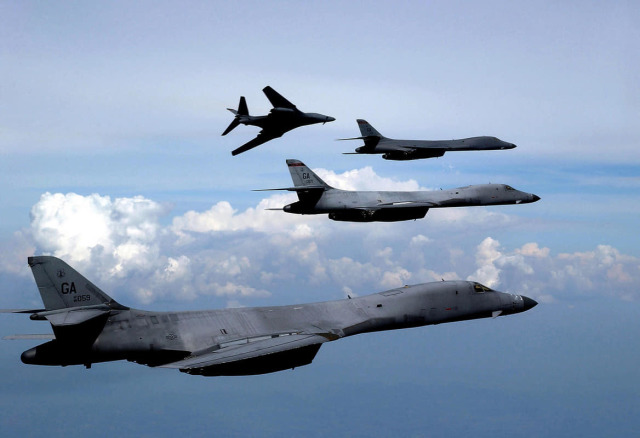
B-1 "Lancer"Operational parameters include a service ceiling of 9,150 m, a maximum speed of Mach 1.2 (1,468 km/h) and an "intercontinental" flight range.
The payload capacity of the currently deployed B-1B is 34,000 kg and is the largest of all USAF combat aircraft. Initially, the B-1 dual-purpose bomber was converted in 2007-2011 to transport exclusively conventional ammunition.
Operationally, the Lancer is still capable of attacking strategically important targets from a long distance. To do this, he uses an unobtrusive AGM-158A JASSM cruise missile (the firing range, depending on the variant, ranges from 425 to 2,220 km, or 230-1200 m. miles).
B-2 Spirit bomber
The B-2 Spirit, which entered service in 1997, is called the only strategic bomber of the US Air Force with fully developed stealth characteristics, covering reduced acoustic, thermal, electromagnetic, radar and visual profiles at all altitudes. Therefore, it is considered as a real deep penetration bomber, which is currently in service with the American bomber fleet. Nevertheless, the US Air Force expects that the developed enemy air defense systems of an equal level will reduce the effectiveness of the inconspicuous B-2 technologies in the coming years.
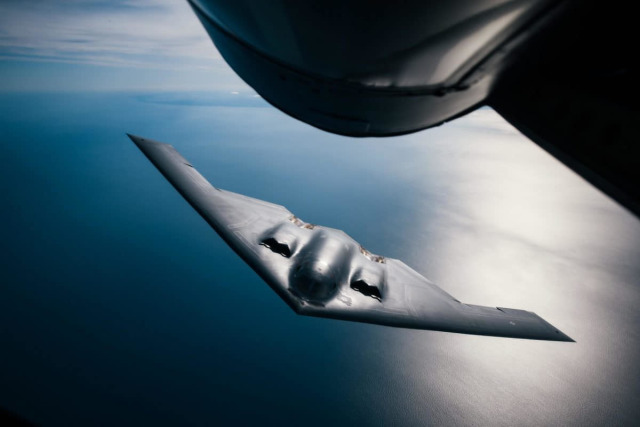
B-2 SPIRIT approaching refuelingThe aircraft has a working range of 11,100 km (6,000 m. miles) without refueling.
In the past, he independently transferred directly from the United States to the Balkans or Afghanistan, where he struck ground targets, after which he returned to his base without an intermediate landing. The payload weighing 18,150 kg includes nuclear and conventional weapons (including thermonuclear gravity bombs of variable power B61 and B83 and JASSM with conventional warhead).
Initial plans called for the purchase of 135 aircraft. However, the end of the Cold War prompted the US Department of Defense to limit production to 20 operational units.
The strategic bomber of the 21st century
It is expected that the B-1 and B-2 will begin to be written off in the 2030s, when the new B-21 "Raider" bomber will enter service. These earlier-than-planned write-offs reflect the budgetary and personnel need to maintain a constant total number of bomber forces of about 175 aircraft (although such top-level figures may vary, and there has been an upward trend recently). The choice of the US Air Force in favor of replacing two younger aircraft instead of the B-52 reflects the latter's large and versatile payload capacity, easier maintenance and, not least, the ability to deploy new long-range weapons currently being designed.
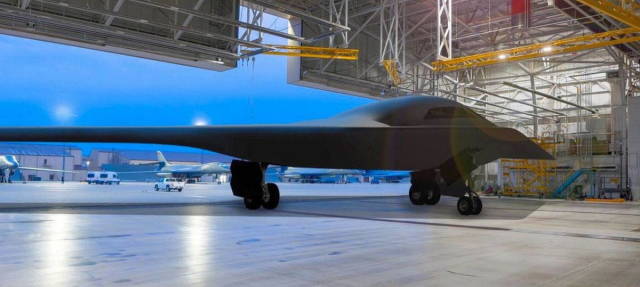
A B-21 Raider bomber at one of the operational bases of the US Air ForceThe B-21 model is being developed by Northrop Grumman for operations in high-tension environments characterized by advanced sensors and enemy air defense systems.
It is claimed that the stealth technology of the model is three decades more advanced than that of the B-2, and is expected to allow deep penetration missions even against opponents of equal level.
The open architecture design will ensure frequent updating of aircraft systems, which will guarantee its capabilities corresponding to new technologies and rapid adaptability to changes in the threat environment. Most of the technical and operational characteristics of the new bomber remain classified. Conceptual graphics released by the US Air Force demonstrate the design of the "batwing", similar to the B-2. At the same time, some analysts come to the conclusion that the depicted "Raider" looks somewhat smaller than "Spirit".
It is planned to place a wide range of nuclear and conventional ammunition on the Raider. The concept of operation provides for the integration of the bomber with various auxiliary platforms, including reconnaissance means. According to statements made by Air Force Secretary Frank Kendall in December 2021, the aircraft will be accompanied (and interacted with) by attack UAVs (operated by the B-21 crew) and electronic warfare aircraft. The configuration of the B-21 itself provides for optional manned or unmanned operation, although this will not be possible on the earliest production aircraft.
As of the end of 202, the first six aircraft were in production, with the first unit outwardly almost completed. It was reported that this first test aircraft passed half of the ground tests, including successful performance on the first and most critical load calibration test. Ground flight tests, including engine tests and high-speed runs, are expected in early 2023. The first flight has also been postponed to 2023, that is, with a delay of about six months. Neither the US Air Force nor Northrop Grumman explained the reason for the delay, stating in May 2022 that the program remains within the established schedule and cost and performance benchmarks.
The US Air Force continues to assess the availability of the first aircraft to perform tasks in the "mid-2020s". Although the volume of production remains classified, Northrop Grumman announced in April 2022 that the initial stage of low-rate production would start in 2023. It will take place simultaneously with the development and production phase "for a certain period of time" to accelerate the acquisition. The start of full-scale production is scheduled for 2025-2026.
The officially announced volume of purchases of the US Air Force is at least 100 aircraft (according to other sources up to 145). When the reserves reach sufficient depth, the model will replace the B-52 as the basis of the strategic bomber forces of the United States. At the same time, the operation of Stratofortrestss will continue. Moreover, it is assumed that the respective strengths of each aircraft will contribute to the implementation of a comprehensive mission.
Prospects for unmanned bombers
In addition to the optional manned B-21, the US Air Force also plans to introduce a cheaper, fully unmanned bomber as a partner of the Raider. Speaking at the aviation symposium of the Air Force Association in March 2022, the Minister of the Air Force F.Kendall presented the concept of a "family of long-range strike systems" with an unmanned strategic bomber complementing the B-21. The unmanned component must match the B-21 in range and speed, as well as have a "reasonable payload". F. Kendall stressed that the development of the concept is in the early stages and that no decision has been made regarding a nuclear or conventional payload for "potentially attractive" UAVs.
Speaking at the same forum, Randall Walden, director of the Rapid Capabilities Office, which oversees the development of the B-21, confirmed that the US Air Force is serious about developing an unmanned bomber. He suggested that in relation to the B-21, the drone can act as a tracker, neutralizing the enemy's air defense for the manned leader. The Pentagon plans to request funding for research and development of unmanned aerial vehicles in 2023 and 2024. If the risk reduction stage and design competitions give positive results, the availability of UAVs is likely by the end of this decade, R. Walden said.
According to the materials of the resource euro-sd.com
